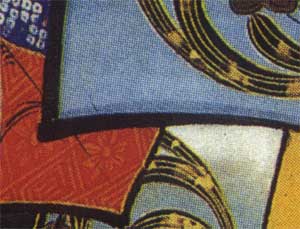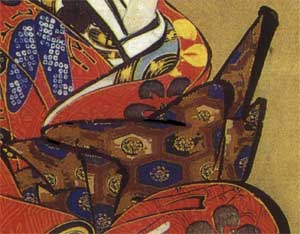March 5, 2006
Now that the main workbench is basically ready, it's time to start some work on the actual printmaking. But I'm still a long way away from getting the knives sharpened! Before I can do any woodcutting, I have to get the design transferred onto the surface of the blocks, and that is going to be a long process.
There is a lot of very good copier technology around these days, but preparing the hanshita - the sheet that will be pasted onto the wood - isn't something that I can do automatically and photographically. I could take the image I have down to Kinko's and have it shot onto a large sheet of the correct size, which I could then paste down, but there are a number of reasons why that won't be possible for this print:
1) The original is a painting, not a print. When reproducing an original woodblock print, 'all' you have to do is find the original lines, and re-carve them. But here, there are no original lines. Or at least, not any that can clearly be carved. Look at this closeup:

The black line went down onto the silk first, then the painter used a partially opaque blue pigment to fill in an area inside. You can still see a faint part of the black line showing through the blue.
So the 'beautiful' black lines that we see when we stand and look at this scroll are not actually the lines that the artist drew. The Japanese woodblock technique uses transparent pigments, so I have to make a decision right now as to which way to go:
- carve the black line to match the visible part of the original line
- carve the black line to match the full original line (if I can find it!)
This decision has to be made now, because the colour blocks will of course have to match the lines that I carve ...
2) The 'lines' of the original are not so beautiful in themselves. Honestly speaking, although Kaigetsudo Ando is a revered master of his era, the lines brushed on this painting are in many places not well done at all.

Now I'm sure that he knew what he was doing, and if this is what he thought was OK at that time, then so be it. But he has built up his black lines with repeated strokes of a smaller brush, something antithetical to the woodblock medium, where lines are created by sharp slicing with the knife.
But who am I, to think of 'fixing' the lines of that old master? Well, I'm the carver, and fixing those lines is just my job. That's the way it was back then, and that's how it still is. Although this particular painting was not done with the intention of being turned into a print, even if it had been so, the painter wouldn't have done anything differently. He just put the strokes down in place; cutting beautiful lines from them was just what the carver was expected to do.
3) The original painting has been damaged. Here and there on the painting - specifically in the obi area - pigment has chipped off and disappeared.

I am going to have to reconstruct the missing lines. I think there is enough left to show me what the pattern basically looked like, but this will have to be done before carving begins.
So I think you can see that there is no way that I can carve directly from a photographic reproduction of this painting. The answer? Simple. I have to get out my brush and pens, and make a tracing of not only all the important lines in the image, but all the patterns too, deciding exactly where to place each line, and use that to guide my carving.
My work for the next couple of weeks is ready and waiting ...

